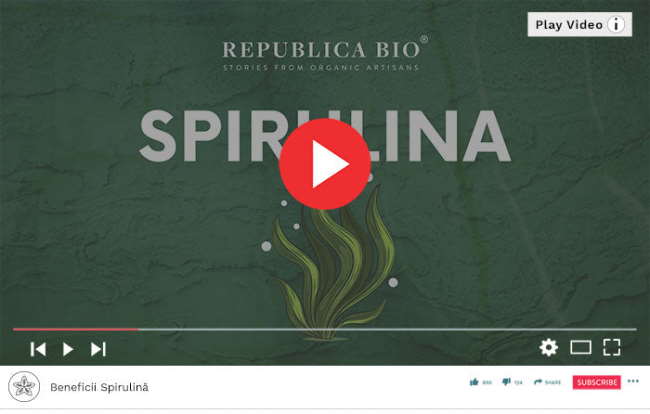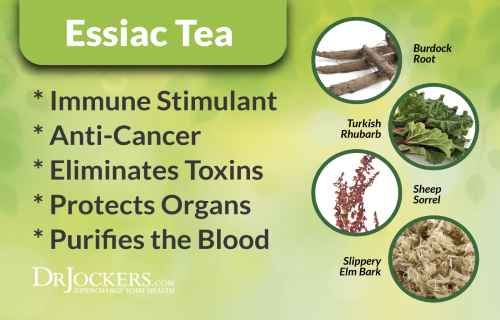
Rumors of a cancer-curing tea originating in the forests of Ontario, Canada, surfaced in the 1920s. The tea’s ingredients remained secret for decades. Canadian nurse Rene M. Caisse held the only recipe, and she protected it until just before her death.
Caisse said the herbal recipe came from an English miner’s wife. The wife claimed a Native American healer from Ontario had cured her of breast cancer with the tea 20 years earlier. Caisse named the tea Essiac (the reverse spelling of her last name) and reportedly gave it to cancer patients for free.
Not only are its origins and healing properties steeped in mystery, Essiac is also linked to federal restrictions on its use, a report of toxicity and a death.
Today, thousands of people with cancer, including some with mesothelioma, use Essiac as an alternative medicine hoping it will help them reach remission. A survey from 2000 found 15 percent of Canadian women with breast cancer use Essiac. In 2006, a separate U.S. survey of 5,051 Essiac users found 22 percent had breast cancer.
The research conducted on Essiac in humans hasn’t held much clout in scientific communities. Results of human studies completed in the 1970s were kept hidden. Some studies of the effect of Essiac on cancer cells in test tubes or in animals have been published, but no peer-reviewed scientific journal has published any clinical trial of Essiac in humans.
Caisse alleges she observed an 80 percent survival rate among all cancers with Essiac treatment. This claim has never been backed by records or scientific study.
Despite its secretive history, the herbs in Essiac may offer some health benefits.
Essiac tea is made from a blend of herbs with potential health benefits, though only its purported anticancer effects have been studied — with conflicting results.
In fact, the tea has been shown to stimulate breast cancer growth in test-tube and animal studies.
Research on the anticancer effects of Essiac tea has had conflicting results.
For example, one test-tube study showed that the tea had antioxidant properties and prevented damage to cells and DNA, which could potentially help protect against cancer .
Another test-tube study noted that Essiac tea blocked the growth of breast and leukemia cancer cells when administered in high concentrations .
There is also some anecdotal evidence that certain types of cancer have responded well to Essiac tea — including one case report of a man who went into remission from prostate cancer and attributed it to the tea.
However, plenty of studies have found little to no effect of Essiac tea on cancer development, including one review of 17 animal studies that detected no anticancer properties .
Multiple other animal and test-tube studies have also shown that Essiac tea has no effect on cancer cells and, in some cases, may even stimulate the growth of breast cancer cells.
Additionally, because human studies are currently unavailable, more high-quality studies are needed to understand how Essiac tea may impact cancer development in the general population.
A 2007 Canadian study conducted in a lab with no human test subjects revealed Essiac contains more antioxidant properties than red wine or green tea. No antibacterial effects were observed. But Essiac did stimulate several immune system cells and enzymes.
The National Institute for Occupational Safety and Health examined the antioxidant power of Essiac in a 2006 study. The study found Essiac protected DNA from free radical damage. This DNA-protective effect won’t repair damage that already led to cancer, but it could have a preventative effect with long-term use.
Secret Recipe Brews Controversy
The origins of the recipe are debated because several of the herbs are not indigenous to North America and reportedly hadn’t yet made it to the Americas through trade routes when Caisse first promoted the tea.
Originally, Caisse brewed three of the herbs into a tea and injected the other herb intramuscularly. No one but Caisse knew which herbs were brewed and which one was injected.
The secrecy of the recipe and preparation became a road block to scientific research and a source of controversy in later investigations.
Essiac is rooted in Native American medicine, specifically, from the Ojibwe tribe in Canada. The reason we know about it today is because of a Canadian nurse named Rene Caisse. In the mid 1920′s Rene was working as head nurse at a hospital in Ontario.
The story goes that one day she noticed scar tissue on an elderly patient and when she inquired about it, the woman told her it was from breast cancer, but it had been healed by a recipe given to her by an ojibwe medicine man. This was amazing to Rene because back then cancer was a virtual death sentence. The woman was almost 80 years old and the cancer never came back. She told Rene the names of the herbs she used. Over a year later, Rene learned that her aunt had cancer in her liver and stomach and had only a few months to live. Rene talked to Dr. R.O. Fisher, her aunt’s doctor, about the herbal tea and he agreed to try it since there was nothing else he could do for her.
Rene’s aunt went on to live another 21 years after being deemed untreatable by the medical community. Word spread about her aunts miraculous recovery and soon, doctors were asking to try her tea on other hopeless patients. Many recovered and even among the worst cases, the tea improved their conditions enough to ease their pain and allow them to live several months longer than doctors expected. Rene went on to open a clinic where she treated thousands of people with her tea free of charge.
You would think the people in charge of our health care would be interested in this wonderful gift… And they were, but not interested in researching and administering it but in suppressing it. The Medical establishment has fought essiac since day one. It is a threat to their profits. The herbs literally grow like weeds and the tea can be made by almost anyone with a kitchen. A cheap cure for cancer shuts down a multi billion dollar industry On October 7th, 1926, 8 doctors signed a petition to the Department of Health asking that Rene be given opportunity to officially research and prove the effectiveness of this tea.
This brought the attention of the Canadian government and started a long drawn out battle over the fate of Rene’s tea. In 1938, a bill was introduced to the Ontario congress that would allow Rene Caisse to officially practice medicine and treat patients with essiac. Along with this bill was presented a petition with over 55,000 signatures. The 59 members of parliament voted and the bill was just 3 votes shy of passing!
Benefits of Essiac Tea?
The original herbal ingredients of Essiac eventually became known: Burdock root, rhubarb root, sheep sorrel and slippery elm bark.
Research on these herbs show they have compounds that protect DNA from damage and can influence the immune system.
Roots of burdock and rhubarb have shown anti-cancer effects in test tube and rat studies. But these roots also contain carcinogenic compounds that cause and promote cancer.
A Chinese study showed rhubarb extract significantly reduced pulmonary toxicity among lung cancer patients receiving radiation therapy.
Slippery elm bark contains mucilage, a gelatinous substance that may relieve coughs and throat irritation. It may offer relief to pleural mesothelioma patients coping with pulmonary symptoms.
However, there have been a number of variations on this original formula in recent decades. The most popular “improvement” on Rene Caisse’s formula is called Flor Essence and adds four additional herbs to the mix – watercress, blessed thistle, red clover, and kelp. These additional components are claimed to be able to complement and improve the anti-cancer effects of this herbal health tonic.
The potential role of essiac tea in cancer prevention and treatment gets most of the attention, but essiac tea can also help to relieve inflammation throughout the body, boost the immune system, treat respiratory conditions, stimulate the metabolism, promotes normal digestion and heals skin conditions.
Inflammation: Antioxidant compounds found in sheep sorrel and burdock root also have anti-inflammatory properties that can help people suffering from arthritis, headaches, gout, heart disease, joint disorders, muscle aches, hemorrhoids and a range of other common inflammatory issues.
Digestion: The mucilage found in slippery elm is able to promote digestive efficiency and eliminate symptoms of constipation and bloating. Similarly, sheep sorrel is a laxative, which can speed up the digestive process and flush out the digestive tract, which can often eliminate harmful bacteria that have set up residence in the gut.
Metabolism: This unique blend of herbs has a stimulating effect on the body, which results in better metabolic function and even passive fat-burning, which is good for hormone and enzyme production, as well as weight-loss efforts.
Immune System: Studies have shown that the combined antioxidant effects of essiac tea’s ingredients are greater than that of green tea, meaning that these herbs can give a major boost to.
Take a look at this collection The Lost Book Of Remedies, taken word for word out of a circa 1845 manual.
What is The Lost Book of Remedies? The Lost Book of Remedies PDF contains a series of medicinal and herbal recipes to make home made remedies from medicinal plants and herbs. Chromic diseases and maladies can be overcome by taking the remedies outlined in this book. The writer claims that his grandfather was taught herbalism and healing whilst in active service during world war two and that he has treated many soldiers with his home made cures.
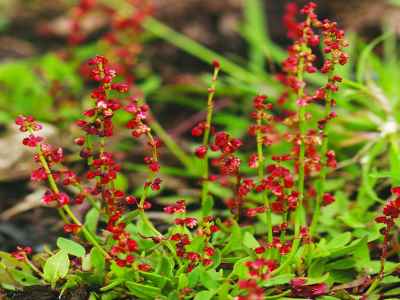
Sheep Sorrel
This herb, taxonomically known as Rumex acetosella, is a rich source of beta-carotene, vitamin A, vitamin C, and other carotenoids; in fact, it is widely praised as one of the most antioxidant-dense herbs available to natural healers and has potent anti-viral properties (Gescher K et al., 2011). Studies on sheep sorrel have found that it does have anti-proliferative effects on cancerous cells, meaning that it can prevent the replication and metastasis of cancerous growths. Furthermore, it is well known as a blood purifier, further cleansing the areas of infection. Rene Caisse claimed that this ingredient was the most powerful cancer-fighting element in essiac tea.
5 Health Benefits of Sorrel
What is sorrel? It’s a perennial, edible herb from the same family as buckwheat and rhubarb. It’s often cultivated as a garden herb or leaf vegetable, but some varieties also grow wild.
This herb has a bright and tart flavor that adds an interesting and super healthy punch of flavor to any dish. It’s also available in supplement and tincture form for a variety of health ailments. That’s because it’s shown the following benefits.
1. Reduces Mucus
Sorrel has a drying effect on the body, which makes its consumption an excellent natural way to reduce mucous production. (1) The reason why it’s so good at reducing mucus is because it contains tannins, which you might be familiar with if you’re a tea drinker.
Tannins are astringent, polyphenolic compounds that can be found in some plants. If you have a any issue that involves an overproduction of mucus, such as the common cold, then sorrel can help reduce that mucus and get you feeling better even faster!
2. Helps Fight Cancer
Sorrel’s high vitamin A and C content makes it excellent for the immune system, which means it can possibly benefit cancer, among other immune-based ailments. The variety of sorrel known as sheep sorrel is one of four ingredients in the herbal cancer treatment known as Essiac tea. Sheep sorrel has been known about for over a hundred years as a cancer-fighting herb and is said to be “the main cancer-killing herb” in Essiac.
3. Improves Sinus Infections
Sorrel is commonly used to help reduce inflammation and pain that accompanies sinusitis, more commonly referred to as a sinus infection. As a high-antioxidant herb, especially its high vitamin C content, it’s awesome at reducing swelling and providing pain relief, which are both key when it comes to sinus infections.
4. Soothes Canker Sores
Fresh sorrel leaves can actually be used as a natural remedy to soothe canker sores. Simply take a fresh leaf and hold it against your canker sore for about a minute. You can repeat as needed. This is such a quick, easy and natural way to relieve canker sores.
5. Equalizes Blood Pressure
Sorrel’s significant potassium content is nothing less than outstanding when it comes to human health. Potassium is an essential mineral that we should consume on a daily basis. It’s not only a vasodilator, but it’s also key to maintaining fluid balance throughout the entire body.
By consuming potassium-rich foods like this beneficial herb, you can reduce stress on your heart and entire cardiovascular system by relaxing the arteries and blood vessels. This results in lowered blood pressure, which decreases the chances of dangerous health complications like blood clots and coronary heart disease.
Types of Sorrel
Sorrel is the name for a variety of hardy perennial herbs belonging to the Polygonaceae, or buckwheat, family that are widely distributed in temperate regions around the world. The leaves are the part of the plant typically eaten, and they look similar to spinach leaves. The raw leaves are described as having a flavor similar to lemon, kiwifruit or sour wild strawberries.
There are several varieties of sorrel, including:
- Broad-leaf/common/garden sorrel (Rumex acetosa) is the type most readily available at markets and nurseries for planting. It’s a deep-rooted perennial that lasts for years and years if it finds a spot it likes. It has a sharp flavor and somewhat large, arrow-shaped leaves.
- French or buckler-leaf sorrel (Rumex scutatus) is also cultivated, but it has a milder flavor than common sorrel with smaller, more rounded leaves.
- Sheep’s sorrel (Rumex acetosella) is about as sour as the common kind but with smaller leaves. It’s typically foraged rather than cultivated and grows wild in the U.S.
- Red-veined sorrel (Rumex sanguineus) is a variety with deep red veins running through its leaves. Some say it’s the least tart variety.
Sheep Sorrel vs. Red Clover
You may confuse this herb with red clover — however, while they do share some characteristics, the two are different.
Sheep Sorrel:
- Helps naturally treat cancer
- Enhances the flow of urine
- Treats fevers and inflammation
- Remedies kidney and urinary tract diseases
- Remedies intestinal parasites
- Helps variety of digestive problems
- Has a cooling effect on the liver
- Contains tannins, which reduce mucous production
Red Clover:
- Helps prevent cancer
- Relieves indigestion
- Reduces high cholesterol
- Treats coughs
- Remedies asthma & bronchitis
- Treats sexually transmitted diseases
- Contains isoflavones that are changed in the body to phytoestrogens, which are similar to the hormone estrogen
Sorrel Nutrition Facts
This herb’s leaves are chock-full of healthy nutrients. Just one cup (133 grams) of sorrel contains:
- 30 calories
- 0.9 gram fat
- 4.3 grams carbohydrates
- 2.7 grams protein
- 3.9 grams fiber
- 5,300 IU vitamin A (106 percent DV)
- 63.6 grams vitamin C (106 percent DV)
- 136 milligrams magnesium (34 percent DV)
- 3 milligrams iron (17 percent DV)
- 519 milligrams potassium (14 percent DV)
- 0.2 milligram vitamin B6 (10 percent DV)
- 50 milligrams calcium (5 percent DV)
Sorrel History & Use Around the World
Historically, sorrel has been used as a salad green, spring tonic, diarrhea remedy, weak diuretic and soothing agent for irritated nasal passages. Sorrel has been used with other herbs to treat bronchitis and sinus conditions in Germany since the 1930s.
During the Middle Ages, prior to citrus fruit’s European introduction, it was used to supply a sour flavor to various dishes. It’s had and continues to have an interesting culinary place in the lives and history of people all over the world:
- In Romania, wild or garden sorrel is used to make sour soups, in open sandwiches, stewed with spinach, and added fresh to lettuce and spinach in salads.
- In Russia and Ukraine, it’s used to make a soup called green borscht.
- In Croatia and Bulgaria, it’s used for soups or with mashed potatoes, or as part of a traditional dish containing eel and other green herbs.
- In rural Greece, this herb is used with spinach, leeks and chard in spanakopita.
- In the Flemish part of Belgium, the preserved pureed variety is mixed with mashed potatoes and eaten with sausages, meatballs or fried bacon as a traditional winter dish.
- In Vietnam, it’s added to lettuce and in salads for Bánh Xēo.
- In Brazil and Portugal, it’s typically eaten raw in salads or used to make soups.
- In India, the leaves are used in soups and curries.
- In Albania, the leaves are simmered and served cold marinated in olive oil.
How to Find & Use Sorrel
Unfortunately, sorrel isn’t easily or commonly found at your local supermarket. Your best bet is to look for it in spring and summer at farmers markets and specialty stores. It starts showing up in the spring and gets progressively more bitter as the growing season goes on.
Sorrel is somewhat in between an herb and a green. As a leafy herb, it can be chopped up and added to dressings, marinades and soups. When it comes to figuring out the best use for your particular bunch, know that short leaves are best raw and larger leaves are better for cooking. Younger leaves tend to be more tender and don’t hold up well in cooking so they’re best in uncooked dishes. The larger leaves can be used in stir-fries and other cooked dishes. You can even include this herb among other cooked greens like kale and spinach for a lemony accent.
Many cooks classically pair sorrel with cream, sour cream or yogurt, which flavors the rich, creamy base but also cuts the sourness of the sorrel. If the bitterness is too strong for you, then blanching the leaves helps minimize the bitterness. It’s also delicious with rich, oily fish like salmon.
When it comes to storing sorrel properly, there are two options. If you’re going to use it within a day or two, then you can simply keep it loosely wrapped in plastic in the fridge. For longer storage, rinse the it clean, pat it dry and roll the leaves up in paper towels before putting them in the plastic wrap in the fridge.
If you’re looking to purchase sorrel in supplement form, you can find it as a tincture, in a capsule and as a tea. It can also be found as a main ingredient in a supplement that contains a mixture of herbs, like Essiac tea.
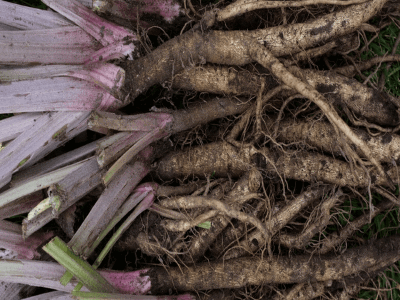
Burdock Root
This element of essiac tea contains anthraquinone, a chemical that is well known to slow tumor growth and prevent cellular mutation, which is what leads to cancer. In fact, anthraquinone is found in a number of mainstream cancer drugs due to its powerful anti-mutagenic effects. Studies conducted by Chan YS et al. have found that burdock root extract has apoptotic effects on cancerous cells, meaning that it stimulates cell death in those malignant cells, without harming healthy cells around it.
Burdock root tea has a long list of health benefits such as detoxifying the body, healing the liver, preventing chronic disease, reducing inflammation, boosting the immune system, healing respiratory infections, improving hair health and soothing stomach disorders. Some of the side effects of drinking this tea include uterine contractions, as well as allergic reactions in the form of contact dermatitis. Burdock root toxicity can occur when consumed in high doses and may include dizziness, headache, dry mouth, sweating, fever, and slurred speech. Again, when this tea is taken in moderation, it is widely considered a safe and beneficial health tonic.
What is Burdock Root Tea?
This popular herbal tea is scientifically known as is made by steeping the dried root of the burdock plant, which has the scientific name Arctium lappa. It has been in use for hundreds, if not thousands of years, as a traditional medicine in parts of Europe, Asia, and North America. It is also cultivated in many areas due to the medicinal and nutritional properties of its roots, leaves, flowers, and stems. Burdock root can also be cooked and eaten as a root vegetable, but similar nutritional properties can be gained when it is brewed into a tea. Most of the benefits of burdock root tea come from the significant levels of luteolin, quercetin and other antioxidants, as well as vitamin B6, folate, potassium, magnesium, manganese, phosphorous, calcium and iron.
Benefits of Burdock Root Tea
Burdock root tea is particularly beneficial if you want to treat high blood pressure, cold and flu, liver toxicity, arthritis, gout, headaches, chronic inflammation, hair loss, dandruff, indigestion, bronchitis, constipation, acid reflux disease, fever, and edema. Some other best benefits offered by burdock tea are listed below.
Diuretic Effects
In traditional use, burdock root tea was commonly turned to for its diuretic and diaphoretic effects, meaning that it caused sweating and urination in people who drank it. This helped to purify the blood and detoxify the body, as sweating and urination are both ways for the body to expel excess toxins, salts, and water, thereby relieving stress on the liver, lymphatic system, and kidneys.
Heart Health
High potassium levels found in burdock root tea mean that this herbal beverage is excellent for heart health, as it can reduce strain on the cardiovascular system by lowering blood pressure. Potassium not only regulates the fluid balance in the body but also acts as a vasodilator, helping to prevent atherosclerosis, heart attacks, and strokes.
Anticancer Potential
Amongst other pharmacological activities, the burdock root has exhibited properties like antimutagenic and antitumor. This was highlighted by an analysis published in the Asian Journal of Chemistry. Additionally, the paper also acknowledges the presence of polyphenols, which are known to exhibit significant anticancer potential.
Another study has pointed out that roasting treatment on burdock root tea has been observed to increase antioxidants, thus enhancing the antioxidant activity.
Immune System
Notable levels of vitamin C in this root tea help to stimulate the immune system and the production of white blood cells, while also boosting collagen production and speeding the healing and recovery process following an illness.
Liver Function
A number of studies have shown that burdock root tea can help speed the regrowth process of liver cells following serious diseases, such as cirrhosis and hepatitis. The liver is a precious organ that can be easily damaged, making this brew very important to individuals with blood-borne diseases or alcohol-induced damage.
Hair Care
The phytosterols found in burdock root tea, as well as the essential oils in the root, can prevent hair loss and improve the health of the scalp and follicles, eliminating dandruff and other common issues.
Inflammation
In natural health traditions, burdock root tea was often recommended for people suffering from headaches, fever, aches, pains and joint disorders. This is due to the anti-inflammatory nature of this herbal tea, and people still turn to this brew for similar conditions. For those with gout, research has shown that the compounds in burdock root tea can decrease levels of uric acid in the blood, improving this condition.
Respiratory Issues
This herbal tea has both, expectorant and decongestant properties, so if you’re suffering from a cough, cold or flu-like symptoms, a cup or two each day can help cut through the phlegm and mucus, while the antibacterial nature of the tea can attack the underlying infection to speed healing.
How Do You Make Burdock Tea?
Making burdock root tea is quite simple, provided you have access to fresh burdock root. You may also purchase burdock root tea that has already been shredded and roasted, and therefore ready to brew. Let’s take a look at the step-by-step procedure to make burdock tea.
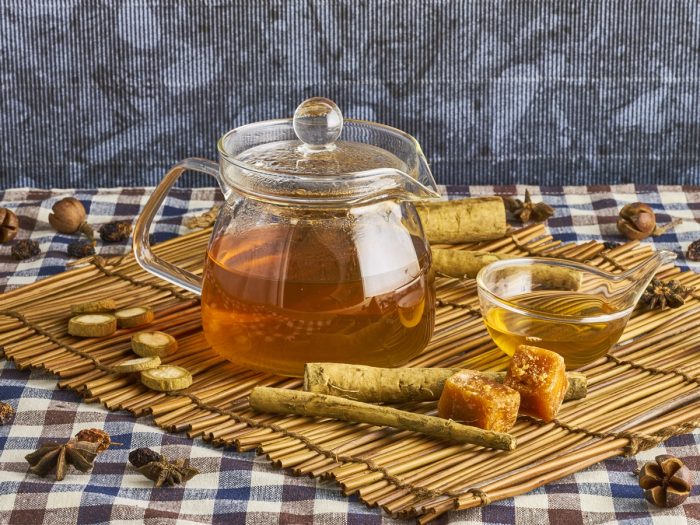
Burdock Root Tea Recipe
Burdock tea is a herbal tea that can help you cleanse your body of all the toxins. So if you have partied hard the previous night and want to detoxify the next day, this the beverage you must have! So let’s take a look at how to make this potent tea at home.
Prep Time45 minsCook Time15 minsTotal Time1 hrCourse: BeverageCuisine: JapaneseAppliance: Stove Servings: 2 cupsAuthor: Ishani Bose
Ingredients
- 8-10 burdock root strips
- 2 cups water filtered
- 1 tsp organic honey or sugar
Instructions
- To make burdock root tea, first, buy fresh burdock roots. Begin by cutting them into 1-2 inch chunks. Then, using a potato peeler or a knife, shred the root chunks into thin strips, which might look like bark peelings. Place this outside to dry in the sun for a few hours.
- Once they are dry, place them in a frying pan and heat them up, but do not use oil. They should roast quite easily if you heat them for 5-10 minutes and you want the color to be a rich golden brown. Once they are cooled, they can be brewed into burdock root tea. Store the excess for later use in a mason jar kept in a cool, dark and dry place.
- Place the burdock root strips in a teapot. Once done, bring the water up to a boil in a stainless steel pot.
- Remove the stainless steel pot from the stove and let it cool for 2-3 minutes. Then pour it into the teapot.
- Allow the mixture to steep for 5-10 minutes.
- Thereafter, pour the tea, add any natural sweeteners to it, and enjoy!
Burdock tea has a soothing and pleasant flavor. You may find its smell quite strong and you may even find its taste to be sweet and crisp, but you may add a bit of honey or lemon juice to improve the flavor if you don’t find it palatable.
Identifying and Harvesting Burdock
Burdock root can be harvested anytime from spring through fall. A burdock root is shaped like a slender carrot, but brown on the outside and a lighter color within.
In addition to being eaten as a vegetable, the root is also the part of the burdock plant that is usually used for medicine. Burdock roots have been taken internally as a blood purifier, digestive aid, and to treat chronic skin problems including psoriasis. They also have a reputation as being good for hangovers!
Burdock grows in sun or partial sunlight. It is a biennial that grows a rosette of leaves in its first year of growth, then flowers and goes to seed the following calendar year.
The leaves can be huge, up to 2 feet long and 1 foot wide. They remind some people of rhubarb plants, but unlike rhubarb’s leaves, burdock leaves have a felt-y, fuzzy texture and are whitish on the undersides. Although untoothed, the margins of the leaves are wavy, almost ruffled.
In the spring of its second calendar year, after overwintering, burdock sends up a stalk that will eventually bear brush-like purplish flowers. These are followed by the burrs from which the plant gets its common name. Burdock burrs are what inspired George de Mestral to invent and patent Velcro.
The immature flower stalks are another excellent vegetable this common plant provides. Similar to the Italian vegetable cardoon, burdock stalks should be harvested before the plants flower, which is usually in mid to late spring.
The premise is that many modern day medicines work on the basis that they treat the symptoms and not the cause, but contained within The Lost Book of Remedies are a number of tinctures and tonics made from plants and leaves that will treat the cause of the illness, thus eradicating the disease altogether.
The book is a direct copy of the little notebook carried around by the author’s grandfather when treating his patients. However, the illustrations of the plants have been updated to photographs so that they are easier for you to identify.
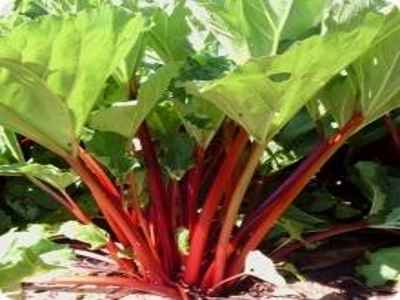
Indian Rhubarb Root
A 2018 animal study on Indian rhubarb root by researchers in Egypt showed that it may reduce the progression of cancer cells in the liver. The researchers concluded that the root has the potential to be used in the treatment of hepatocellular carcinoma and clinical trials with humans are required.
What is Rhubarb?
Rhubarb is the name used to describe several plant species in the genus Rheum, native to China, Iran, Turkey, and India. Its underground storage organs – roots and rhizomes – have been used in traditional Chinese medicine since the third millennium BC. Rhubarb has been historically used to heal a wide variety of issues such as constipation, fever, inflammation, and kidney failure .
More recently, it was uncovered that Rhubarb can also alleviate symptoms of menopause and sepsis, a life-threatening response to infection .
Rhubarb is known for its very sour, celery-like stalks, which vary in color, from pale pink to pale green. While the stalks can be used for cooking, the leaves are very poisonous. Some common varieties of rhubarb include :
Chinese rhubarb (Rheum officinale or Rheum palmatum)
Garden or culinary rhubarb (Rheum rhabarbarum)
Rhapontic rhubarb or false rhubarb (Rheum rhaponticum L.)
Syrian rhubarb (Rheum ribes L.)
The most commonly used parts of the plant for medicinal purposes are the roots and rhizomes, which contain :
Various plant pigments (anthraquinone compounds such as aloe-emodin, chrysophanol, emodin, and rhein)
Laxative phenolic compounds (anthraquinone glycosides such as sennosides)
Antioxidant phenolic compounds (catechins)
Other phenolics (naphthalenes, glucose gallates)
Polysaccharides (complex sugars)
Rhubarb contains toxic compounds known as salts of oxalic acid/oxalates, which are not broken down during cooking. These compounds are highly concentrated in the leaves, which should not be consumed .
Anthraquinone compounds such as sennosides are well-known laxatives that stimulate bowel movements. These compounds are not absorbed in the intestine and reach the colon unchanged. Gut bacteria then break them down into active metabolites, which reduce the amount of water the colon reabsorbs. This increases the fluid content and volume in the stool, easing constipation .
Other anthraquinone compounds such as aloe-emodin, emodin, and rhein have antibacterial properties. They may work by disrupting cell membranes of bacteria and their protein and energy production. Aloe-emodin can also act as a laxative .
Aloe-emodin, emodin, and rhein can also kill cancer cells and prevent metastasis by blocking excessive cell division .
Stilbenes contribute to rhubarb’s cholesterol-lowering, antioxidant, and liver-protective effects [8].
Health Benefits of Rhubarb
1) Liver Diseases
Non-Alcoholic Fatty Liver Disease
A Chinese herbal medicine containing rhubarb called Danning Pian improved non-alcoholic fatty liver disease symptoms and reduced ALT levels, a marker of liver damage .
Cirrhotic Ascites
A very common and serious complication of liver cirrhosis is a buildup of fluid in the abdominal area (cirrhotic ascites). In a clinical trial of 92 people, Xiaozhang Tie, a Chinese herbal medication with rhubarb, moderately reduced abdominal swelling and overall symptoms. It was given alongside conventional treatment .
Genetic Disorders of the Liver
Infantile cholestatic hepatitis syndrome is a rare genetic disorder that causes bile build-up in the liver of newborns. Rhubarb was 89% effective at reducing jaundice, yellowish pigmentation of the skin that indicates bile buildup. This points to the potential of rhubarb to greatly enhance liver function .
Kidney Failure
In people with chronic kidney failure, levels of blood urea nitrogen (BUN) and creatinine are often high, as the kidneys struggle to eliminate waste products from the blood. Supplementation with 1 g/day of rhubarb normalized levels of BUN, creatinine, and other waste products (clinical trial of 48 people) .
Similarly, a Chinese herbal supplement containing rhubarb (Niaodujing) increased the removal of creatinine from the blood in a clinical trial of 105 people with chronic kidney failure .
Taking a Chinese herbal combination with rhubarb, Rheum E, helped slow the progression of chronic kidney failure in a clinical trial of 30 people. It was effective both alone and in combination with a drug for high blood pressure called Captopril .
In another study, Chinese rhubarb with Captopril also normalized levels of a marker of kidney dysfunction (IL-6) in the urine of people with chronic kidney failure .
Combined with dialysis, a Chinese medication with rhubarb (Xinqingning) reduced uremia, a buildup of toxins in the blood. It helped slow the progression of chronic kidney failure (clinical trial of 57 people). Baoyuan Dahuang Decoction, a different rhubarb-containing Chinese mixture improved the quality of life in people with chronic kidney failure .
To sum it up, various Chinese herbal remedies containing rhubarb show benefits for people with kidney failure by reducing overall symptoms and the buildup of waste products.
Diabetic Kidney Disease
Kidney disease is a common complication of diabetes. When people with this condition took a Rhubarb-containing Chinese herbal mixture (Tangshen Recipe) with their insulin, they experienced a similar improvement in biomarkers to those taking conventional anti-diabetes drugs with insulin .
Kidney Inflammation
In a clinical trial of 32 people with kidney inflammation, a rhubarb-containing Chinese herbal remedy (Decoction of Qingre Huoxue) added to steroidal anti-inflammatory drugs improved kidney function better than the drugs alone. This remedy may allow for the dosage of steroids to be lowered while achieving equal anti-inflammatory benefits .
Lowers Cholesterol
Consuming 27 g/day of ground rhubarb stalks reduced total and LDL cholesterol by 8 – 9% in a clinical trial of 10 men. Levels started to rise again one month after stopping rhubarb. The benefits were most likely due to the high fiber content of the powder .
Similarly, in a clinical trial of 83 people with clogged arteries, a Chinese rhubarb preparation (50 mg/kg) lowered total and LDL cholesterol and also improved artery health.
In pregnant women with high blood pressure, Chinese rhubarb reduced levels of triglycerides and LDL cholesterol, while increasing levels of HDL cholesterol .
Cultivation—
Rhubarb may be raised from seed, but it is better and more usual to obtain established roots. Seeds may be sown, however, in drills a foot or more apart, in the open, from March to April, and the young plants thinned out to 10 inches, transplanting them in the autumn, allowing about 4 feet every way to each plant.
Rhubarb roots may be planted at any time of the year, although mild weather in autumn or early spring is best; it should be planted on a clear, open spot, on good soil, which should be well trenched 3 feet deep, and before planting, a good substance of rotten manure should be worked into the soil.
When the plants are to be increased, it is merely necessary to take up large roots and divide them with a spade: every piece that has a crown to it will grow. Fresh plantations are generally made in February or March, but Rhubarb may still be divided early in May.
To ensure fine rhubarb for table use, a large dressing of well-rotted manure should be dug in about the roots as soon as the last of the leaves have been pulled. It is not right to wait until the winter, before the plants are dressed.
Old roots ought to be divided and replanted every fourth or fifth year, when the plants are grown for the use of the stems.
If Rhubarb be forced on the ground where it grows, nothing more is required than to cover with large pots, half casks, or boxes, round and over which should be placed plenty of stable manure. Roots forced in greenhouse or in frames do not need to have the light excluded from them. Such roots, however, require dividing and replanting in the spring out of doors.
The roots and rhizomes of Rhubarb have been used in various cultures around the world, from Iran and India to Russia and China.
This herb is especially important in Traditional Chinese Medicine (TCM), which considers it a vital remedy for various diseases. Scientific studies have confirmed numerous benefits that range from gut, liver and kidney protection to reducing inflammation and fighting infections. Rhubarb is often combined with other herbs and dietary changes to achieve synergistic effects in TCM.
Common rhubarb, on the other hand, is an effective and gentle remedy for women. It can soothe menstrual pain and may help women experience fewer symptoms transitioning to menopause. Some studies suggest it may also help reduce anxiety and boost mood in women around menopause.
The parts of rhubarb medicinally used are generally very safe and cause few side effects. It’s also important to keep in mind that Rhubarb has laxative action, which is desired in some cases but may cause discomfort in others. The leaves of Rhubarb are toxic and should not be consumed.
If you’re considering supplementing with this herb, make sure to get a formulation suited to your needs. Many products exist, often in combination with other herbs.
If you are looking for a healthier way to treat some of your health problems, while enjoying a beautiful garden, medicinal plants you can grow in your garden are an excellent alternative to taking modern medicines. Just dry your herbs and create your own natural pharmacy.
Many of the prescription drugs available today have a long list of possible bad side effects, some of which may even be worse than the medical problem you’re trying to treat. This is why many people are searching for a more natural, safer way to treat their medical problems.
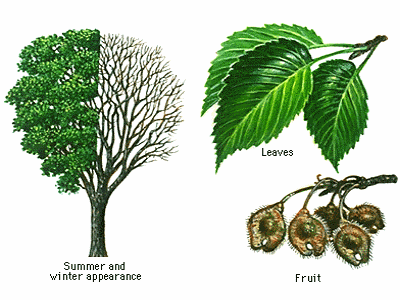
Slippery Elm (Inner Bark)
This herbal ingredient contains plant sterols, tannins and essential fatty acids that can reduce inflammation, as well as mucilage and calcium oxalate, which helps this herb detoxify the body. In combination with the other elements of essiac tea, slippery elm protects the health of organs from the effects of mainstream cancer treatments, while simultaneously supporting the immune system.
Slippery elm (Ulmus rubra) is a type of elm tree native to eastern North America from southern Quebec to northern Florida and east to Texas. The inner bark has long been used in traditional Native American medicine to treat wounds and gastrointestinal ailments.
Slippery elm contains a type of soluble fiber known as mucilage. Mucilage traps and absorbs water, forming a gel-like substance that can coat mucous membranes, providing short-term relief of pain and inflammation The high calcium content may also act as a mild antacid.
Slippery elm is also known as red elm, gray elm, soft elm, moose elm, and Indian elm. It should not be confused the American elm (U. americana), the species of which it resembles but has no medicinal properties.
Health Benefits
Slippery elm has long been used in folk medicine. It is either taken orally or applied topically to aid in the healing of cuts and burns. Among some of the conditions slippery elm is believed to treat are:
Acid reflux
Constipation
Inflammatory bowel disease (IBD)
Irritable bowel syndrome (IBS)
Mouth ulcers
Sore throat
Weight loss
Some proponents claim that slippery elm can treat upper respiratory tract infections, syphilis, herpes, gout, psoriasis, and even breast or lung cancer. To date, there is no clinical evidence to support these claims.
Weight Loss
There are some who insist that slippery elm can promote weight loss by suppressing the appetite and “detoxing” the bowel. The presumption is that the production of mucilage can increase the volume of your stomach contents, filling you up faster. The mucilaginous bulk is then believed to “trap” dietary fats and speed bowel clearance. The hypothesis is yet to be proven.
A 2018 study in the Journal of Dietary Supplements found that women provided a four-week course of a slippery elm supplement experienced no differences in body composition or waist size compared to those given a placebo.
Despite this, there are some who consume slippery elm powder as a porridge-like gruel to “amplify” these effects. Not only is there no evidence that this works, but it is also unknown how safe the practice is.
Sore Throat
Slippery elm has been used to make commercial medicines as far back as the 1840s when a physician named Henry Thacker starting producing herbal remedies for sale to doctors. Among them was a slippery elm elixir that was first sold as an oral suspension and later as lozenges. As a natural demulcent, slippery elm can reduce inflammation by coating lining of the throat and esophagus.
Thacker’s Slippery Elm Lozenges are still produced today, in addition to a slippery elm lip balm used to treat chapped lips. Other manufacturers have since joined in, producing slippery extracts, tinctures, lotions, and herbal teas.
In the 1960s, the U.S. Food and Drug Administration classified slippery elm as a botanical drug, believing it safe for the treatment of minor sore throat pain.
However, the agency fell short of declaring it effective, characterizing slippery elm as “a demulcent with limited clinical effects.”
While slippery elm is believed by some to relieve the symptoms of acid reflux, the drug action is relatively short-lasting (around 30 minutes) and does nothing to treat the underlying causes of reflux.
Best Medicines for Sore Throat Reviewed
Digestive Disorders
Proponents of slippery elm claim that it can alleviate many of the symptoms of inflammatory bowel diseases (such as ulcerative colitis) by forming a temporary protective barrier in the intestines. To date, the evidence of this is mixed.
A 2002 study from England found that slippery elm exerted antioxidant effects on colon tissue samples taken from people with ulcerative colitis. What the test tube study did not show is whether the same effect would occur if a slippery elm was taken orally.
Meanwhile, other scientists have looked into whether slippery elm can control the symptoms of irritable bowel syndrome (IBS), classified either as constipation-predominant IBS (IBS-C) or diarrhea-predominant IBS (IBS-D).
A 2008 study from Australia reported that two different herbal supplements containing slippery elm were able to increase bowel frequency by 20 percent in people with IBS-C but had minimal effect in people with IBS-D.
Both groups were also said to experience improvements is straining, abdominal pain, and bloating. Despite the positive findings, the conclusions were limited by the fact that the research was conducted by a commercial herbal drug manufacturer.
Dosage and Preparation
There are no guidelines for the appropriate use of slippery elm. While slippery elm is considered safe when used for the short-term treatment of sore throat, you shouldn’t assume that is can be used with impunity. As a general rule, never exceed the recommended dose on the product label.
Slippery elm remedies are typically made from the powdered inner bark of the tree. The powder is then used to manufacture supplements in capsule form or to create extracts for use in tinctures, lozenges, salves, and lip balms. Slippery elm powder can also be purchased in bulk or packaged in tea bags.
Is slippery elm an endangered species?
Slippery elm is not yet an endangered species, but there are grave fears about its sustainability. Their preferred habitat, the floodplains, have been aggressively targeted for urban development and channel construction. Because the timber is not of much commercial use, little effort has been made to replant the trees.
Moreover, due to the onslaught to Dutch Elm Disease, there are very few mature slippery elm trees left in nature.
Do you know about the gift of nature to save the life of people from various health problems and make them feel secure by curing significant issues? How to live healthy in this world without having chronic diseases or illness or any other health issues which may hurt you physically and mentally? Due to dense population, people are trying to demolish the forest, garden areas to create shelter, so they forced to destroy the nature’s gift such as natural ingredients, secret medicinal herbs and more which are grown in wild forest, mountains and other places. When you read this review entirely, sure you will get chance to know about secrets medicinal ingredients, herbs and more used by our ancestor to get back the lost health without losing your life. Claude Davis was highlighted all the stuff in the form of the e-book The Lost Book Of Remedies filled with a list of natural ingredients and remedies that you can quickly grow in the backyard or at free space to include it in your routine diet or external usage to get well soon.
The Lost Book of Remedies is the revolutionary e-book which is suitable for one of the tools in survival kit because the creator of this program was mentioned lots of benefits about natural medicinal herbs and ingredients to make you feel safe, secure by protecting the health of yourself and dependents in any crisis. Even you can plant it in your backyard to grow effective medicinal herbs to save the life of anyone without wasting your money and time. This e-book will guide you on the right path to provide security, water, food, and all the medicines for securing your life or loved ones at all the time. This guide discussed the common plants that are grown in your backyard, but you don’t know the benefits of that plan which may help you to overcome any significant issues. Sometimes it may replace your antibiotic pills, reduce inflammations, stops bleeding, reverse arthritis, lowers cholesterol, regulates blood sugar level, defeats degenerative brain diseases and much more.

Books can be your best pre-collapse investment.
Carnivore’s Bible (is a wellknown meat processor providing custom meat processing services locally andacross the state of Montana and more. Whether your needs are for domestic meator wild game meat processing)
The Lost Book of Remedies PDF ( contains a series of medicinal andherbal recipes to make home made remedies from medicinal plants and herbs.Chromic diseases and maladies can be overcome by taking the remediesoutlined in this book. The writer claims that his grandfather was taughtherbalism and healing whilst in active service during world war twoand that he has treated many soldiers with his home made cures. )
Easy Cellar(Info about building and managing your root cellar, plus printable plans. The book on building and using root cellars – The Complete Root Cellar Book.)
The Lost Ways (Learn the long forgotten secrets that helped our forefathers survive famines,wars,economic crisis and anything else life threw at them)
LOST WAYS 2 ( Wordof the day: Prepare! And do it the old fashion way, like our fore-fathers did it and succeed longbefore us,because what lies ahead of us will require all the help we can get. Watch this video and learn the 3 skills that ensured our ancestors survival in hard times offamine and war.)



